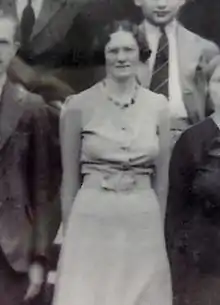Helen Knight
(Elsie) Helen Knight (née Weil, 24 November 1899 – 1984) was a British philosopher. She was one of few women active in the early days of analytic aesthetics.[1]

Life and education
Knight was born in Swiss Cottage, London and attended Fremarch School, Hampstead. She began her BA at Bedford College, London, before coming to Cambridge University in 1921 where she took Part II Moral Sciences in 1923 and obtained a first class degree. From 1923 to 1925 she was a Research Student at Newnham College. She married psychologist Rex Knight on 30 January 1926 (they divorced in 1936), and then appears to have taken a break from academic philosophy until 1932 when she returned to Newnham as Sarah Smithson Research Fellow. She obtained her PhD in 1935. During the war she was Principal at the Board of Trade, a position that had been temporarily filled by fellow philosopher Margaret MacDonald. She also taught English at an independent girls boarding school, North Foreland Lodge in Kent from 1942 to 1949.[2]
Career
Knight was one of a select group to whom Ludwig Wittgenstein dictated his Blue and Brown Books in the 1930s, which outline the transition in Wittgenstein's thought between his two major works, Tractatus Logico-Philosophicus and Philosophical Investigations.[3]
Knight became a member of the Aristotelian Society in 1922, acting in its Executive Committee for several terms. Between 1935 and 1941 she was a researcher in Aesthetics at Cambridge. During this time she published occasional papers on aesthetics for different philosophical journals (Mind, Philosophy and others).[4] In 1945 she addressed the Aristotelian Society talking about the Women's Graduate Club in Cambridge. "Judging by the calibre of co-presenters, discussants and commentators of her papers, her work was admired and taken seriously.".[5]
In 1949 Knight emigrated to Australia where she was a tutor in English Literature at Janet Clarke Hall, University of Melbourne until the 1960s.[6] She died in Melbourne, Australia aged 84.[7]
Publications
Although she published scantly, her work was well received and continues to be included in modern anthologies of aesthetics.[8]
- Helen Knight (1930). Aesthetic Experience in Pictorial Art. The Monist 40 (1):74-83.
- Helen Knight (1930). Sense-Form in Pictorial Art. Proceedings of the Aristotelian Society 31:143 - 160.
- Helen Knight (1931). Philosophy in Germany. Philosophy 6 (23):370 - 376.
- Helen Knight (1936). Stout on Universals. Mind 45 (177):45-60.
- Helen Knight (1935). The Use of "Good" in Aesthetic Judgments. Proceedings of the Aristotelian Society 36:207 - 222.
References
- Zeglin Brand, Peggy (2010). Feminism and Tradition in Aesthetics. Penn State Press. p. 19. ISBN 9780271043968.
- Newnham College Roll Card
- Klagge, James (2003). Ludwig Wittgenstein: Public and Private Occasions. Rowman & Littlefield Publishers. p. 345. ISBN 0742512703.
- Waithe, Ellen (1995). A History of Women Philosophers Vol. 4. p. 330.
- Waithe, Ellen (1995). A History of Women Philosophers Vol. 4. p. 330.
- Oppy, Graham (2011). The Antipodean Philosopher. Lexington. p. 70. ISBN 9780739127339.
- "Births, Deaths and Marriages". Family History Search. State Government of Victoria. Retrieved 23 November 2015.
- Beardsley, Monroe (1981). Aesthetics: Problems in the Philosophy of Criticism. Hackett. ISBN 0915145081.